David Lopez-Paz
From Bytes to Ideas: Language Modeling with Autoregressive U-Nets
Jun 17, 2025Abstract:Tokenization imposes a fixed granularity on the input text, freezing how a language model operates on data and how far in the future it predicts. Byte Pair Encoding (BPE) and similar schemes split text once, build a static vocabulary, and leave the model stuck with that choice. We relax this rigidity by introducing an autoregressive U-Net that learns to embed its own tokens as it trains. The network reads raw bytes, pools them into words, then pairs of words, then up to 4 words, giving it a multi-scale view of the sequence. At deeper stages, the model must predict further into the future -- anticipating the next few words rather than the next byte -- so deeper stages focus on broader semantic patterns while earlier stages handle fine details. When carefully tuning and controlling pretraining compute, shallow hierarchies tie strong BPE baselines, and deeper hierarchies have a promising trend. Because tokenization now lives inside the model, the same system can handle character-level tasks and carry knowledge across low-resource languages.
A Differentiable Rank-Based Objective For Better Feature Learning
Feb 13, 2025Abstract:In this paper, we leverage existing statistical methods to better understand feature learning from data. We tackle this by modifying the model-free variable selection method, Feature Ordering by Conditional Independence (FOCI), which is introduced in \cite{azadkia2021simple}. While FOCI is based on a non-parametric coefficient of conditional dependence, we introduce its parametric, differentiable approximation. With this approximate coefficient of correlation, we present a new algorithm called difFOCI, which is applicable to a wider range of machine learning problems thanks to its differentiable nature and learnable parameters. We present difFOCI in three contexts: (1) as a variable selection method with baseline comparisons to FOCI, (2) as a trainable model parametrized with a neural network, and (3) as a generic, widely applicable neural network regularizer, one that improves feature learning with better management of spurious correlations. We evaluate difFOCI on increasingly complex problems ranging from basic variable selection in toy examples to saliency map comparisons in convolutional networks. We then show how difFOCI can be incorporated in the context of fairness to facilitate classifications without relying on sensitive data.
The Pitfalls of Memorization: When Memorization Hurts Generalization
Dec 10, 2024Abstract:Neural networks often learn simple explanations that fit the majority of the data while memorizing exceptions that deviate from these explanations.This behavior leads to poor generalization when the learned explanations rely on spurious correlations. In this work, we formalize the interplay between memorization and generalization, showing that spurious correlations would particularly lead to poor generalization when are combined with memorization. Memorization can reduce training loss to zero, leaving no incentive to learn robust, generalizable patterns. To address this, we propose memorization-aware training (MAT), which uses held-out predictions as a signal of memorization to shift a model's logits. MAT encourages learning robust patterns invariant across distributions, improving generalization under distribution shifts.
Flow Matching Guide and Code
Dec 09, 2024Abstract:Flow Matching (FM) is a recent framework for generative modeling that has achieved state-of-the-art performance across various domains, including image, video, audio, speech, and biological structures. This guide offers a comprehensive and self-contained review of FM, covering its mathematical foundations, design choices, and extensions. By also providing a PyTorch package featuring relevant examples (e.g., image and text generation), this work aims to serve as a resource for both novice and experienced researchers interested in understanding, applying and further developing FM.
Better & Faster Large Language Models via Multi-token Prediction
Apr 30, 2024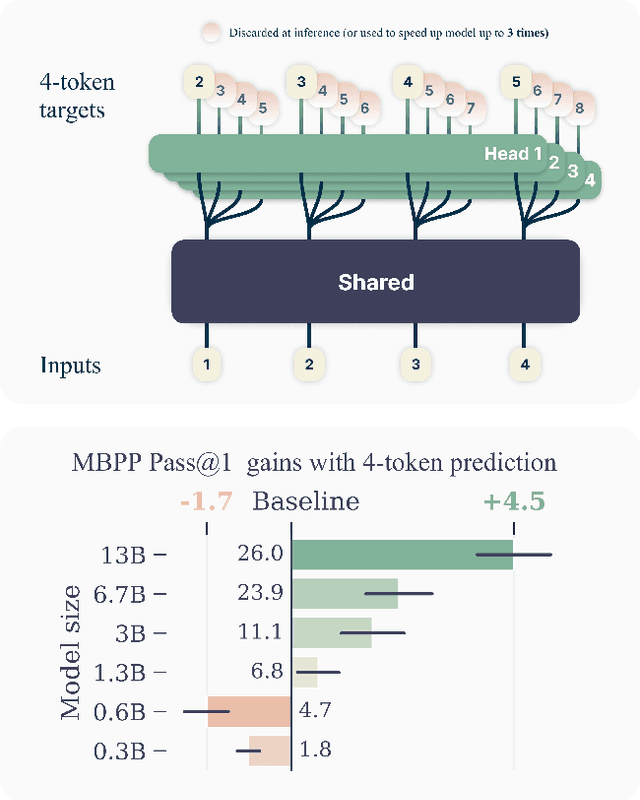
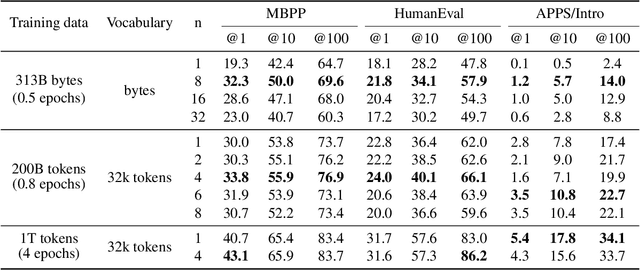
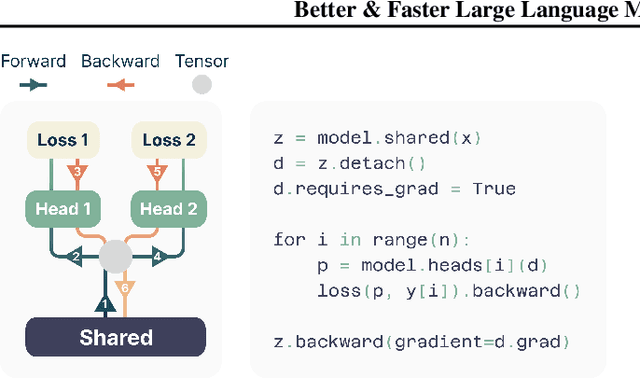
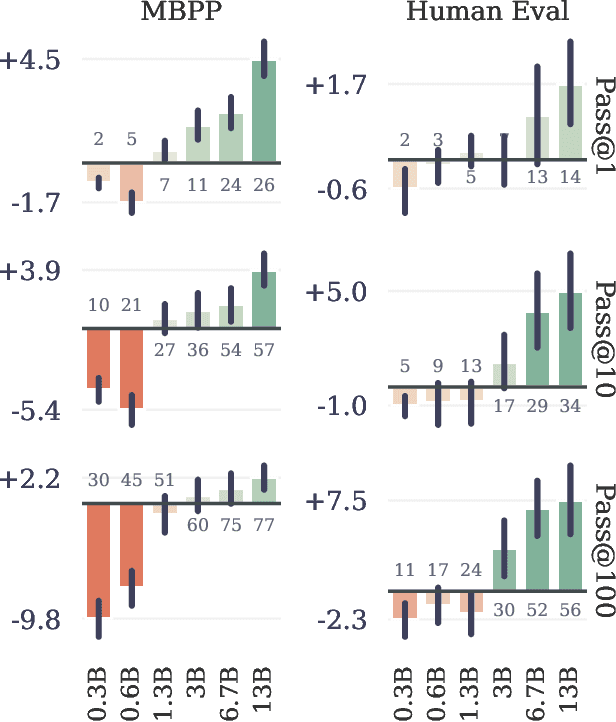
Abstract:Large language models such as GPT and Llama are trained with a next-token prediction loss. In this work, we suggest that training language models to predict multiple future tokens at once results in higher sample efficiency. More specifically, at each position in the training corpus, we ask the model to predict the following n tokens using n independent output heads, operating on top of a shared model trunk. Considering multi-token prediction as an auxiliary training task, we measure improved downstream capabilities with no overhead in training time for both code and natural language models. The method is increasingly useful for larger model sizes, and keeps its appeal when training for multiple epochs. Gains are especially pronounced on generative benchmarks like coding, where our models consistently outperform strong baselines by several percentage points. Our 13B parameter models solves 12 % more problems on HumanEval and 17 % more on MBPP than comparable next-token models. Experiments on small algorithmic tasks demonstrate that multi-token prediction is favorable for the development of induction heads and algorithmic reasoning capabilities. As an additional benefit, models trained with 4-token prediction are up to 3 times faster at inference, even with large batch sizes.
Unified Uncertainty Calibration
Oct 02, 2023Abstract:To build robust, fair, and safe AI systems, we would like our classifiers to say ``I don't know'' when facing test examples that are difficult or fall outside of the training classes.The ubiquitous strategy to predict under uncertainty is the simplistic \emph{reject-or-classify} rule: abstain from prediction if epistemic uncertainty is high, classify otherwise.Unfortunately, this recipe does not allow different sources of uncertainty to communicate with each other, produces miscalibrated predictions, and it does not allow to correct for misspecifications in our uncertainty estimates. To address these three issues, we introduce \emph{unified uncertainty calibration (U2C)}, a holistic framework to combine aleatoric and epistemic uncertainties. U2C enables a clean learning-theoretical analysis of uncertainty estimation, and outperforms reject-or-classify across a variety of ImageNet benchmarks.
Discovering environments with XRM
Sep 28, 2023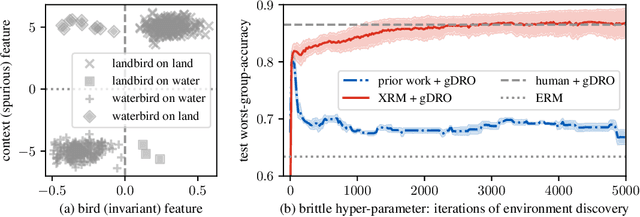

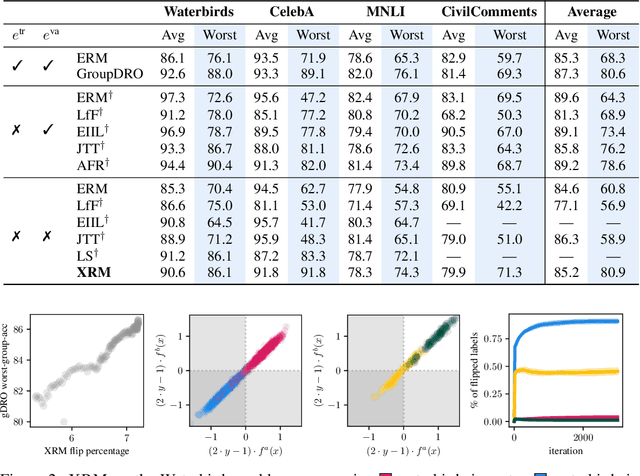

Abstract:Successful out-of-distribution generalization requires environment annotations. Unfortunately, these are resource-intensive to obtain, and their relevance to model performance is limited by the expectations and perceptual biases of human annotators. Therefore, to enable robust AI systems across applications, we must develop algorithms to automatically discover environments inducing broad generalization. Current proposals, which divide examples based on their training error, suffer from one fundamental problem. These methods add hyper-parameters and early-stopping criteria that are impossible to tune without a validation set with human-annotated environments, the very information subject to discovery. In this paper, we propose Cross-Risk-Minimization (XRM) to address this issue. XRM trains two twin networks, each learning from one random half of the training data, while imitating confident held-out mistakes made by its sibling. XRM provides a recipe for hyper-parameter tuning, does not require early-stopping, and can discover environments for all training and validation data. Domain generalization algorithms built on top of XRM environments achieve oracle worst-group-accuracy, solving a long-standing problem in out-of-distribution generalization.
Context is Environment
Sep 20, 2023Abstract:Two lines of work are taking the central stage in AI research. On the one hand, the community is making increasing efforts to build models that discard spurious correlations and generalize better in novel test environments. Unfortunately, the bitter lesson so far is that no proposal convincingly outperforms a simple empirical risk minimization baseline. On the other hand, large language models (LLMs) have erupted as algorithms able to learn in-context, generalizing on-the-fly to eclectic contextual circumstances that users enforce by means of prompting. In this paper, we argue that context is environment, and posit that in-context learning holds the key to better domain generalization. Via extensive theory and experiments, we show that paying attention to context$\unicode{x2013}\unicode{x2013}$unlabeled examples as they arrive$\unicode{x2013}\unicode{x2013}$allows our proposed In-Context Risk Minimization (ICRM) algorithm to zoom-in on the test environment risk minimizer, leading to significant out-of-distribution performance improvements. From all of this, two messages are worth taking home. Researchers in domain generalization should consider environment as context, and harness the adaptive power of in-context learning. Researchers in LLMs should consider context as environment, to better structure data towards generalization.
A Closer Look at In-Context Learning under Distribution Shifts
May 26, 2023Abstract:In-context learning, a capability that enables a model to learn from input examples on the fly without necessitating weight updates, is a defining characteristic of large language models. In this work, we follow the setting proposed in (Garg et al., 2022) to better understand the generality and limitations of in-context learning from the lens of the simple yet fundamental task of linear regression. The key question we aim to address is: Are transformers more adept than some natural and simpler architectures at performing in-context learning under varying distribution shifts? To compare transformers, we propose to use a simple architecture based on set-based Multi-Layer Perceptrons (MLPs). We find that both transformers and set-based MLPs exhibit in-context learning under in-distribution evaluations, but transformers more closely emulate the performance of ordinary least squares (OLS). Transformers also display better resilience to mild distribution shifts, where set-based MLPs falter. However, under severe distribution shifts, both models' in-context learning abilities diminish.
Recycling diverse models for out-of-distribution generalization
Dec 20, 2022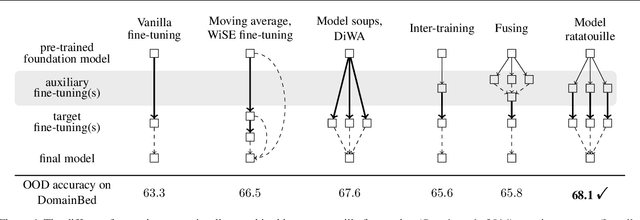

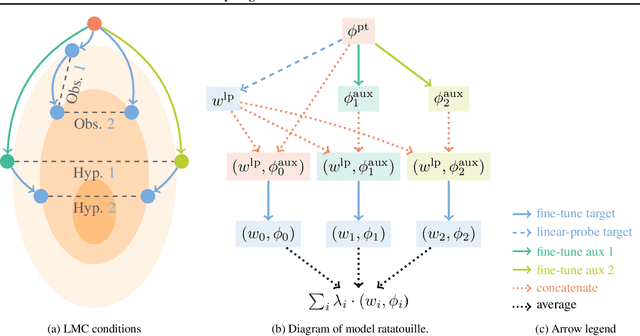

Abstract:Foundation models are redefining how AI systems are built. Practitioners now follow a standard procedure to build their machine learning solutions: download a copy of a foundation model, and fine-tune it using some in-house data about the target task of interest. Consequently, the Internet is swarmed by a handful of foundation models fine-tuned on many diverse tasks. Yet, these individual fine-tunings often lack strong generalization and exist in isolation without benefiting from each other. In our opinion, this is a missed opportunity, as these specialized models contain diverse features. Based on this insight, we propose model recycling, a simple strategy that leverages multiple fine-tunings of the same foundation model on diverse auxiliary tasks, and repurposes them as rich and diverse initializations for the target task. Specifically, model recycling fine-tunes in parallel each specialized model on the target task, and then averages the weights of all target fine-tunings into a final model. Empirically, we show that model recycling maximizes model diversity by benefiting from diverse auxiliary tasks, and achieves a new state of the art on the reference DomainBed benchmark for out-of-distribution generalization. Looking forward, model recycling is a contribution to the emerging paradigm of updatable machine learning where, akin to open-source software development, the community collaborates to incrementally and reliably update machine learning models.
 Add to Chrome
Add to Chrome Add to Firefox
Add to Firefox Add to Edge
Add to Edge